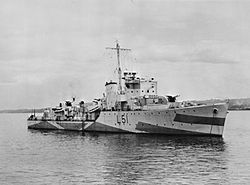HMS Bramham (L51)
|
HMS Bramham , 1942
|
||||||||||||||||||||
|
||||||||||||||||||||
|
||||||||||||||||||||
|
||||||||||||||||||||
|
||||||||||||||||||||
HMS Bramham (L51) was an escort destroyer of the Hunt class Type II of the Royal Navy , which was put into service on June 16 1942nd It was the only ship that bore the name. It was used in the Royal Navy in World War II with the Battle Honors Malta Convoys , Artic and North Africa in 1942 . The destroyer escort was loaned to the Greek Navy as Themistoklis and was the lead ship of the Greek Themistoklis class of three Hunt II destroyers.
History of the ship
The destroyer escort took part in Operation Pedestal with other units made available by the Home Fleet in August 1942 . On the 12th the destroyer was left behind to support the damaged transporter Deucalion . When this did sink, Bramham rescued the shipwrecked. On the 13th, she helped to tow the incapable of maneuvering tanker Ohio into the Grand Harbor on Malta, alongside the destroyer Penn and the sister ship Ledbury . Back at Home Fleet, the ship took part in remote security in Northern Sea Convoy PQ 18 in September . Bramham was one of the two ships that rescued survivors of the Curacoa on October 2, 1942 , after the old flak cruiser was literally cut up by the fast steamer off the North Canal while securing the RMS Queen Mary .
The destroyer escort was then transferred to the Mediterranean Sea to be used in Operation Torch . On November 20, 1942, the destroyer was severely damaged by a bomb hit in the stern while securing a coastal escort off the Algerian coast from Philippeville (now Skikda ) to Bone (now Annaba ). The damaged ship could be towed to Algiers and after an emergency repair came to Gibraltar in tow . After extensive repairs, the Bramham was able to return to England on its own from there, where the final repairs were carried out on the Tyne. Here, where the Greek Navy took over its first four Hunt destroyers immediately after completion in 1942, a Greek crew took over the HMS Bramham .
Service under the Greek flag
In December 1942, Captain Nikos Sarri of the Greek Navy was to take over the ship in England. However, it had suffered damage from an air strike. In March 1943 the ship was handed over and on September 29th it was taken over into the fleet of the Greek Navy and renamed Themistoklis ( Greek Θεμιστοκλής ) after the Athenian general Themistocles . At this point the ship was in Alexandria . The Themistoklis was deployed in the Aegean Sea along with other Greek Hunt destroyers in the autumn of 1943 . In 1944 missions followed in front of Anzio in Italy and in an American unit at the Allied landing in southern France ( Operation Dragon ). In autumn 1944 the ship was relocated to the Aegean again. On September 27, 1944, it sailed to the port of Kapsali on Kythira, making it the first ship to sail into a Greek port after the occupation of Greece during World War II. On December 11, 1946, it was the first ship to come to the aid of the damaged refugee ship Athena . It was returned to the Royal Navy on December 12, 1959 and canceled in Greece the following year.
literature
- Fred T. Jane : Jane's Fighting Ships of World War II , London 1989, ISBN 1-85170-194-X , p. 156.
Web links
- KRITI escort destroyers (1941–1942 / 1943-1946) on navypedia.org (accessed April 10, 2018)
- HMS BRAMHAM (L 51), later Greek HHelMS THEMISTOCLES - Type II, Hunt-class Escort Destroyer on naval-history.net (accessed April 10, 2018)
- HMS Bramham (L 51) on uboat.net (accessed April 10, 2018)
Individual evidence
- ^ Rohwer: Chronicle of the Sea War , August 10-15, 1942 Mediterranean Operation Pedestal .
- ^ Rohwer: Chronicle of the naval war , September 12-18, 1942, North Sea.
- ↑ K. Paisi-Paradeli: Τα ΠΛΟΙΑ του ΠΟΛΕΜΙΚΟΥ ΝΑΥΤΙΚΟΥ 1829–1999 , ISBN 960-86501-1-9 , pp. 67–68.
